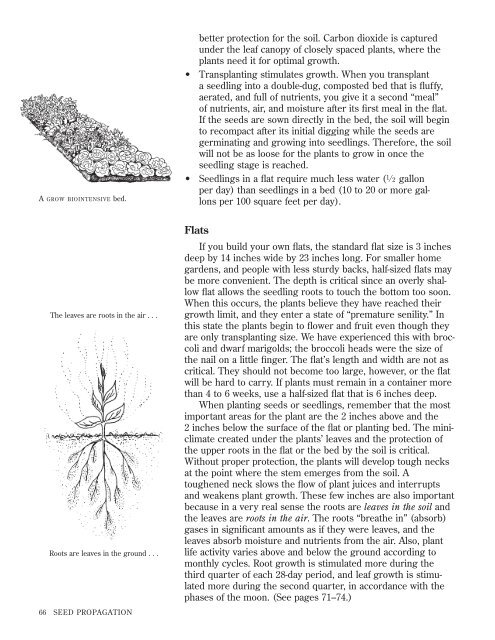How to Grow More Vegetables : And Fruits, Nuts ... - Shroomery
How to Grow More Vegetables : And Fruits, Nuts ... - Shroomery
How to Grow More Vegetables : And Fruits, Nuts ... - Shroomery
Create successful ePaper yourself
Turn your PDF publications into a flip-book with our unique Google optimized e-Paper software.
A GROW BIOINTENSIVE bed.<br />
The leaves are roots in the air . . .<br />
Roots are leaves in the ground . . .<br />
66 SEED PROPAGATION<br />
better protection for the soil. Carbon dioxide is captured<br />
under the leaf canopy of closely spaced plants, where the<br />
plants need it for optimal growth.<br />
• Transplanting stimulates growth. When you transplant<br />
a seedling in<strong>to</strong> a double-dug, composted bed that is fluffy,<br />
aerated, and full of nutrients, you give it a second “meal”<br />
of nutrients, air, and moisture after its first meal in the flat.<br />
If the seeds are sown directly in the bed, the soil will begin<br />
<strong>to</strong> recompact after its initial digging while the seeds are<br />
germinating and growing in<strong>to</strong> seedlings. Therefore, the soil<br />
will not be as loose for the plants <strong>to</strong> grow in once the<br />
seedling stage is reached.<br />
• Seedlings in a flat require much less water ( 1 ⁄ 2 gallon<br />
per day) than seedlings in a bed (10 <strong>to</strong> 20 or more gallons<br />
per 100 square feet per day).<br />
Flats<br />
If you build your own flats, the standard flat size is 3 inches<br />
deep by 14 inches wide by 23 inches long. For smaller home<br />
gardens, and people with less sturdy backs, half-sized flats may<br />
be more convenient. The depth is critical since an overly shallow<br />
flat allows the seedling roots <strong>to</strong> <strong>to</strong>uch the bot<strong>to</strong>m <strong>to</strong>o soon.<br />
When this occurs, the plants believe they have reached their<br />
growth limit, and they enter a state of “premature senility.” In<br />
this state the plants begin <strong>to</strong> flower and fruit even though they<br />
are only transplanting size. We have experienced this with broccoli<br />
and dwarf marigolds; the broccoli heads were the size of<br />
the nail on a little finger. The flat’s length and width are not as<br />
critical. They should not become <strong>to</strong>o large, however, or the flat<br />
will be hard <strong>to</strong> carry. If plants must remain in a container more<br />
than 4 <strong>to</strong> 6 weeks, use a half-sized flat that is 6 inches deep.<br />
When planting seeds or seedlings, remember that the most<br />
important areas for the plant are the 2 inches above and the<br />
2 inches below the surface of the flat or planting bed. The miniclimate<br />
created under the plants’ leaves and the protection of<br />
the upper roots in the flat or the bed by the soil is critical.<br />
Without proper protection, the plants will develop <strong>to</strong>ugh necks<br />
at the point where the stem emerges from the soil. A<br />
<strong>to</strong>ughened neck slows the flow of plant juices and interrupts<br />
and weakens plant growth. These few inches are also important<br />
because in a very real sense the roots are leaves in the soil and<br />
the leaves are roots in the air. The roots “breathe in” (absorb)<br />
gases in significant amounts as if they were leaves, and the<br />
leaves absorb moisture and nutrients from the air. Also, plant<br />
life activity varies above and below the ground according <strong>to</strong><br />
monthly cycles. Root growth is stimulated more during the<br />
third quarter of each 28-day period, and leaf growth is stimulated<br />
more during the second quarter, in accordance with the<br />
phases of the moon. (See pages 71–74.)












